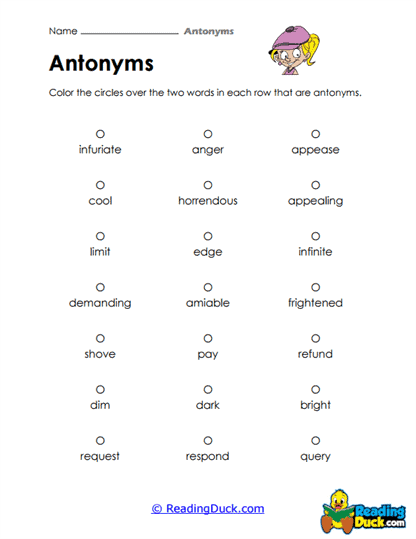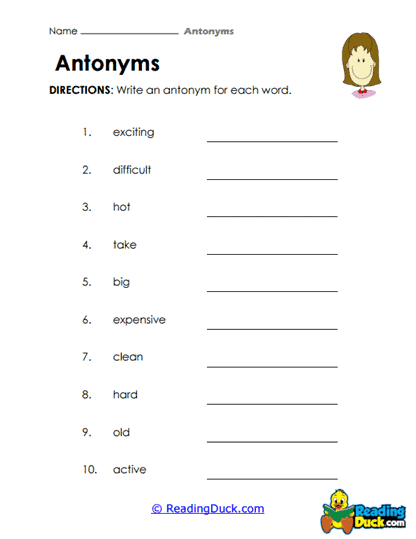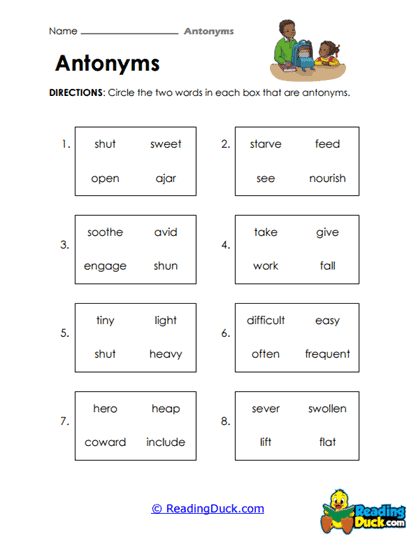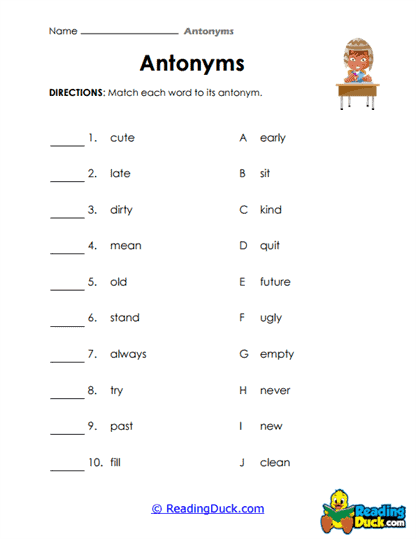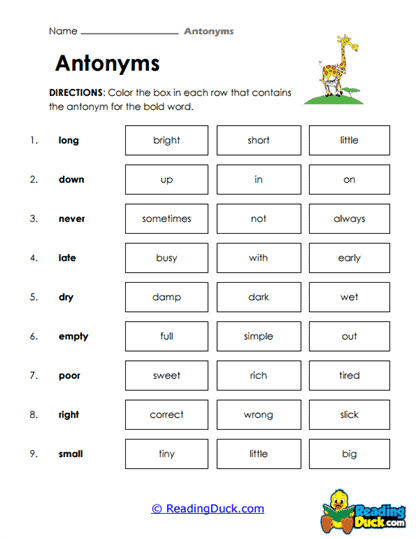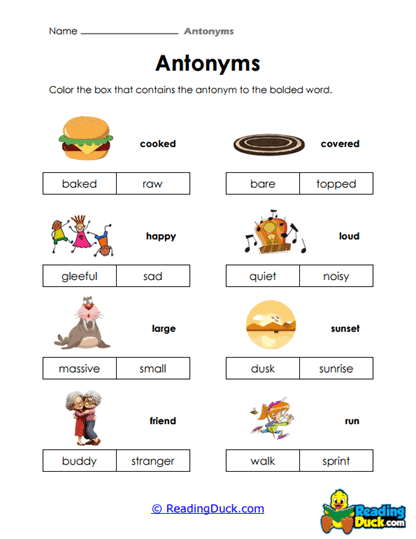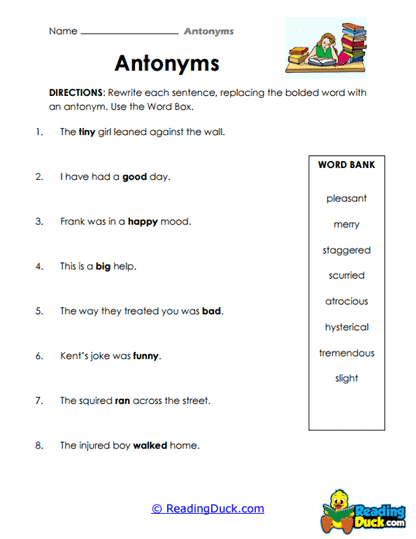Antonyms Worksheets
About Our Antonym Worksheets
Our Antonyms Worksheets collection is a valuable tool that falls under the Language category within the Skills section. These worksheets are designed to help students enhance their understanding of opposites, a fundamental concept in language development. By learning antonyms, students expand their vocabulary, improve their comprehension, and strengthen their ability to distinguish between contrasting ideas. Mastering antonyms allows students to recognize word relationships, which is essential for developing strong reading, writing, and speaking skills.
These worksheets provide a range of engaging activities that focus on identifying, understanding, and using antonyms in various contexts. They guide students in recognizing opposite meanings, helping them develop critical thinking and language skills. The worksheets are presented in a convenient PDF format, making them simple to view, download, and print for both classroom and home use. Additionally, each worksheet includes a downloadable answer key, allowing students and educators to check progress and provide feedback efficiently.
Understanding Antonyms
Antonyms are words that have opposite meanings. They are an important element of vocabulary development, allowing learners to understand how language works by recognizing contrasts between ideas. Antonyms help clarify meaning and bring variety to both written and spoken communication.
What Are Antonyms?
An antonym is a word that means the opposite of another word. Antonyms allow language users to express contrast and emphasize differences between ideas, actions, or qualities.
Types of Antonyms:
-
- Gradable Antonyms: These are antonyms that exist on a spectrum, meaning one word can be more or less of something compared to its opposite. For example, "hot" and "cold" are gradable antonyms because something can be very hot, warm, cool, or very cold.
- Complementary Antonyms: These antonyms represent absolute opposites, where the presence of one means the complete absence of the other. For instance, "alive" and "dead" are complementary antonyms—something cannot be both at the same time.
- Relational Antonyms: These antonyms show a relationship between two ideas, where one word implies the existence of the other. Examples include "teacher" and "student" or "buy" and "sell."
Examples of Antonyms:
Simple Examples:
-
- Happy / Sad
- Big / Small
- Fast / Slow
Complex Examples:
-
- Victory / Defeat
- Generous / Stingy
- Create / Destroy
Understanding antonyms is an essential part of language learning. When students grasp the concept of opposites, they can more easily identify and categorize different aspects of language, which improves their ability to communicate clearly and effectively.
The Versatility of Antonyms in Language
Antonyms play an important role in language by allowing speakers and writers to express contrast, comparison, and nuanced ideas. Their versatility makes them an indispensable tool for conveying clear and precise meaning in communication. Below are several key ways antonyms are used, with examples to illustrate their functions.
Expressing Contrast
One of the most common uses of antonyms is to show contrast between two ideas, people, or objects. By using antonyms, speakers can highlight differences that help clarify meaning and create a stronger impact.
- Example: In the sentence “The room was either hot or cold, but never comfortable,” the antonyms “hot” and “cold” emphasize the extreme nature of the room's temperature, making the description more vivid and relatable.
Strengthening Descriptions
Antonyms allow for more dynamic and varied descriptions. Instead of using repetitive language, speakers and writers can incorporate antonyms to bring richness and complexity to their communication.
- Example: Rather than saying “The weather changed from good to bad,” using antonyms like “The weather shifted from sunny to stormy” provides a more descriptive and engaging picture of the change.
Creating Balance in Comparison
Antonyms help create a balance when comparing two different ideas or conditions. This is often useful in persuasive writing or speaking, where contrast is necessary to present both sides of an argument or idea.
- Example: In a persuasive essay, a student might write, “While some believe that technology isolates people, others argue that it brings them closer together.” The antonyms “isolates” and “brings together” effectively compare opposing viewpoints.
Developing Critical Thinking
By working with antonyms, students also develop their critical thinking skills. Recognizing and using antonyms requires understanding the relationship between words and the context in which they are used.
- Example: A student tasked with finding an antonym for “generous” might first need to reflect on what generosity entails before determining that “selfish” or “stingy” are fitting opposites.
Antonyms enrich communication by adding layers of meaning and precision. They help students express complex ideas in a clear and direct manner, contributing to more effective verbal and written communication.
How Learning Antonyms Improves Literacy Skills
Learning antonyms plays a critical role in enhancing students’ literacy skills. By understanding and using antonyms, students improve their vocabulary, comprehension, and overall language proficiency. Antonyms are more than just opposite words—they are a tool that helps students better understand the nuances of language and how words function in different contexts.
Enhancing Vocabulary
As students learn antonyms, they are exposed to a broader range of vocabulary. Understanding one word and its opposite encourages students to expand their word knowledge, providing them with more options for expression.
- Example: When a student learns the word “brave” and its antonym “cowardly,” they gain two new words that help them describe different behaviors and attitudes. This dual knowledge broadens their ability to communicate with precision.
Improving Reading Comprehension
Recognizing antonyms in texts allows students to better understand contrasts in meaning. This ability is crucial for reading comprehension, as many texts rely on contrasts to convey important information or themes.
- Example: In a story where a character’s mood changes from “optimistic” to “pessimistic,” understanding the antonyms helps students grasp the character’s development and the underlying message of the narrative.
Strengthening Writing Skills
When students use antonyms in their writing, they can craft more compelling and balanced arguments. Antonyms give students the ability to present opposing viewpoints, add variety to their writing, and avoid repetitive language.
- Example: A student writing a persuasive essay might use antonyms to show both sides of an argument, such as discussing the benefits of “freedom” versus the drawbacks of “restriction.”
Enhancing Speaking Abilities
Antonyms also play a key role in verbal communication. Using antonyms in conversation helps students articulate differences clearly and engage in more meaningful discussions. This skill is especially important in debates, presentations, and discussions where contrasting ideas are frequently explored.
Antonyms contribute to a well-rounded literacy foundation by enriching vocabulary, enhancing comprehension, and encouraging clearer, more effective communication.
Engaging Activities to Reinforce Antonym Learning
To make learning antonyms fun and effective, educators can introduce various interactive activities that reinforce the concepts taught in the worksheets. These activities are suitable for students in grades 2 through 5, providing opportunities for both in-class and homeschool settings.
Antonym Match Game
In this activity, students receive cards with words on them. Each student must find a peer whose card contains the antonym of their word. For example, one student might have the word “tall,” while another has “short.” When they find their antonym match, they share sentences that include both words. This activity helps students develop their understanding of opposites in a social and collaborative setting.
Antonym Art
Have students create illustrations that represent pairs of antonyms. For example, a student might draw a picture of a “day” scene with the sun in the sky and contrast it with a “night” scene showing the moon and stars. This artistic approach reinforces the meaning of antonyms through visual representation, making the concept more engaging.
Opposite Day Writing Prompt
Ask students to write a short story in which everything is the opposite of normal. For example, in their story, cats might bark, the sun could rise in the west, or people could walk backward. This activity encourages creativity while reinforcing the concept of opposites in a fun and imaginative way.
Antonym Scavenger Hunt
Organize a scavenger hunt in which students search for objects or situations that represent antonyms. For example, students might find something “heavy” and something “light” or something “new” and something “old.” This activity brings antonym learning into the physical world, helping students make connections between language and real-life experiences.
The Importance of Learning Antonyms for Practical Communication
Learning antonyms equips students with an essential language skill that has numerous real-world applications. Being able to recognize and use antonyms enables students to communicate more effectively, whether they are writing essays, delivering presentations, or engaging in everyday conversations.
In academic settings, antonyms help students improve their ability to analyze texts, compare ideas, and articulate differences in arguments. In professional settings, clear and precise communication often relies on an understanding of antonyms, especially when comparing alternatives or making decisions.
In summary, mastering antonyms is a key component of language development. Our Antonyms Worksheets offer students the tools they need to enhance their vocabulary, comprehension, and communication skills, preparing them for success in both academic and real-world contexts.
